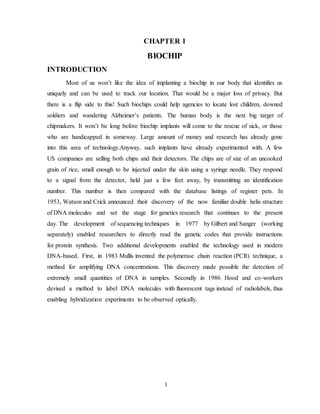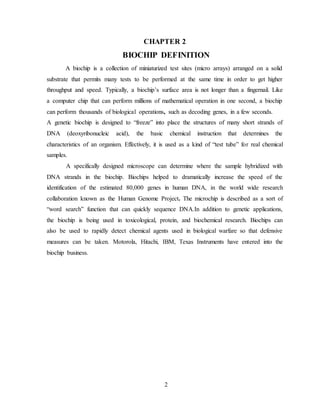The document discusses biochips and their potential applications, including tracking lost individuals and aiding in healthcare, despite privacy concerns. It outlines the structure and functionality of implanted biochips, emphasizing their long life and low energy requirements. However, it also highlights significant societal, ethical, and technical challenges that accompany their development and adoption.





![6
CHAPTER 4
PROBLEMS OF BIOCHIP
A chip implant would contain a person’s financial world, medical history health care
it would contain his electronic life. If cash no longer existed and if the world’s economy was
totally chip oriented; there would be a huge "black-market" for chips! Since there is no cash
criminals would cut off hands and heads, stealing "rich-folks" chips. It is very dangerous
because once kidnappers get to know about these chips, they will skin people to find them,"
There are technological, standardization-related, ethical and societal problems in biochip
development. For biochip market expansion, in addition to technological problems, it is
necessary to overcome social, institutional, marketing and economic problems all together.
For research and development biochips, 'exhaustiveness' is an important technological
requirement because they are used as a 'search tool' to find genes related to diseases and
involved in life phenomena. On the other hand, the technological requirement of diagnostic
biochips is the 'accurate, quantitative and reproducible detection' of specific genes and
proteins characterizing diseases. Accuracy and reproducibility of analytical results are also
required in research and development, even if there includes failing data. By contrast, failing
is not an option in diagnosis on hospital patients. In research and development, researchers
use chips with sufficient knowledge to modify chips to collect necessary data for their
research.[4–8]By contrast, to spread the use of diagnostic biochips widely, it is necessary for
persons unfamiliar with handling biochips to be able to operate them with no errors. Thus,
'simple operation for everybody' is a technological requirement.
Experimental plans can be secured by designing beforehand in research and
development, but the results should be obtained within approximately 1 h to reflect the
results in the prescription of drugs and diagnosis for outpatients, for which the 'rapid
obtaining of analytical results' is a technological requirement.](https://image.slidesharecdn.com/biochipfinalreport-180105144351/85/Biochip-seminar-report-6-320.jpg)

